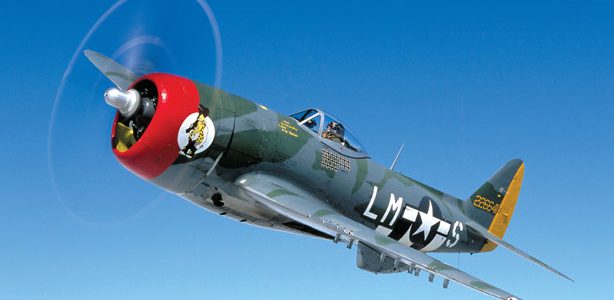I was only 5 feet 4 inches tall when I graduated from flight training in 1943, but my instructors saw something gigantic inside of me. I was one of 60 Second Lieutenants selected out of 400 to go into fighters—P-47 Thunderbolts to be exact. When I first saw the airplane I would fly in combat, my only thought was, “Why in the heck did I ever ask for this behemoth!” But after I flew the Jug for awhile, I really liked it and thought it was a piece of cake to fly—easy to handle, reliable and stable. There was nothing out there that could beat the Jug in a dive; not even a rock! What I admired most about it though were those eight .50caliber machine guns that stuck out of the wings like great big broom handles.
By the time I had arrived in England in 1943, I had 130 hours of P-47 time under my belt, just barley enough to keep me out of trouble. I had great confidence in the airplane and in my abilities as a fighter pilot—you had to have these traits because anything less and you were dead! I also had 20/10 vision, so I could usually spot the Luftwaffe before they spotted me.
Joining the Wolfpack
I was posted with the 61st Fighter Squadron of the 56th Fighter Group—the premier P-47 unit of the entire war. I flew with all of the great leaders including Col. Hub Zemke, Gabby Gabreski, David Schilling and the rest. But the person I was most impressed with was Bob Johnson, the first pilot of the European war to break WW I ace Eddie Rickenbacker’s record. In my mind, Bob was the best of the whole outfit. He was gutsy, aggressive and he would mix it up with the Germans as if he didn’t have a care in the world.
I flew my first combat mission on his wing, and when he spotted the enemy, he turned into me so hard as he went after a Bf 109. I lost track of him for a few minutes as I was pushed into a cloud, but I was thrilled to death when I found him again. He increased his score and in turn, decreased the Luftwaffe’s numbers as they were minus one 109. I learned a lot from these guys and eventually, I too became a flight leader.
I was what you call “conservative-aggressive”—I didn’t stick my neck out when I thought it would endanger my wingman. The thing I learned very quickly in combat was regardless of how many airplanes you attack, the leader can usually get through, get a kill or two, and be out of harm’s way in a flash. It was the guys following behind who would get shot down. I flew 75 missions as flight leader and I am proud to say that everybody in my flight came home. But it was on a mission on May 12, 1944, that my streak almost came to a crashing halt.
By Col. Robert “Shorty” Rankin USAF (ret.),
As told to and written by James P. Busha
Read the article from the August 2012 issue of Flight Journal, click here.
















